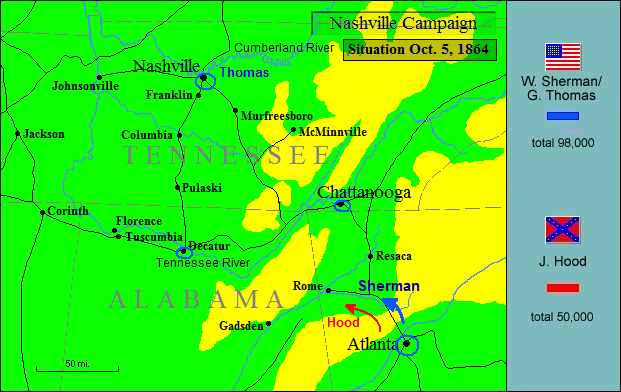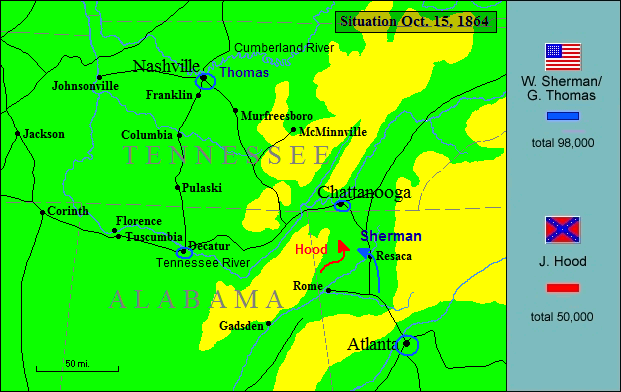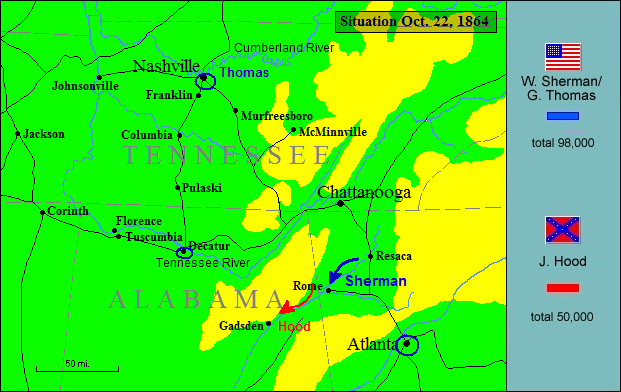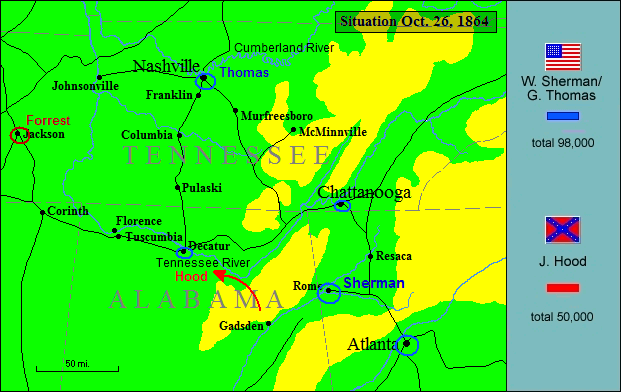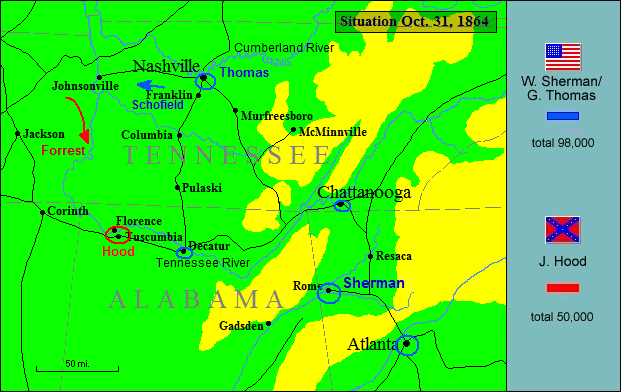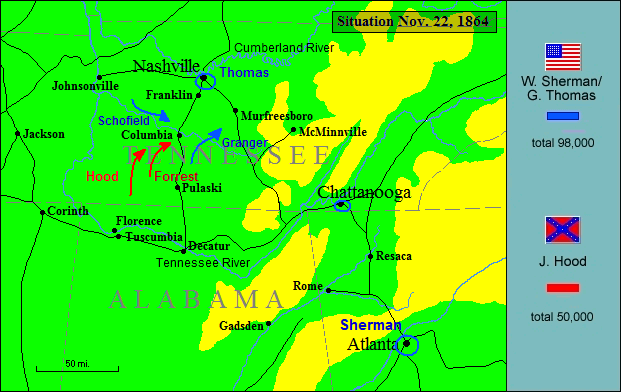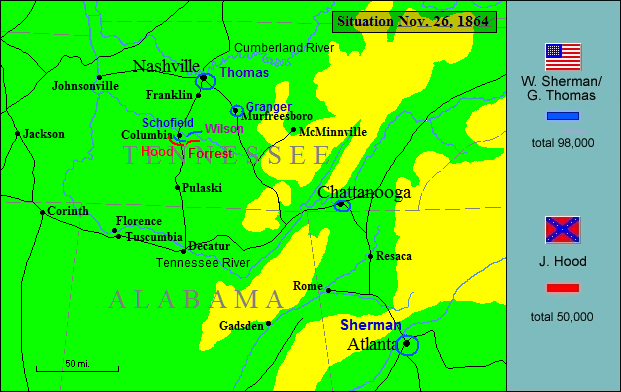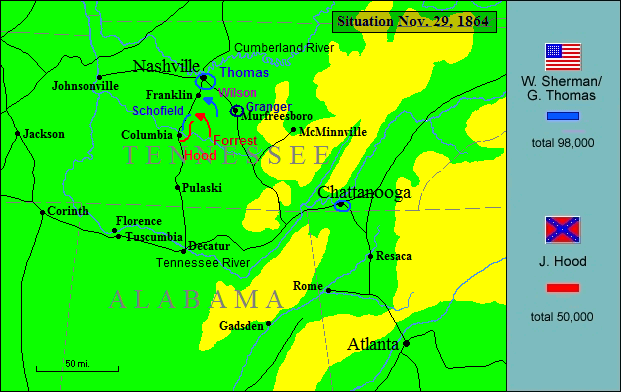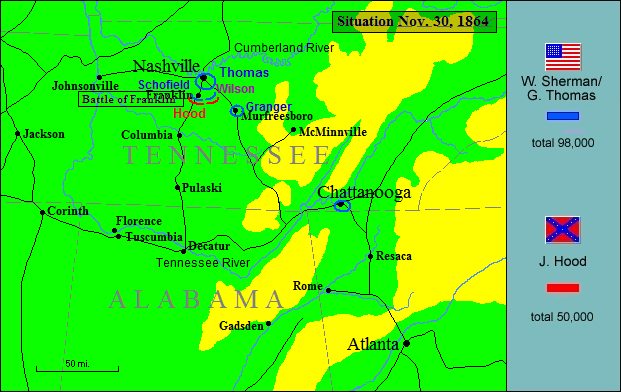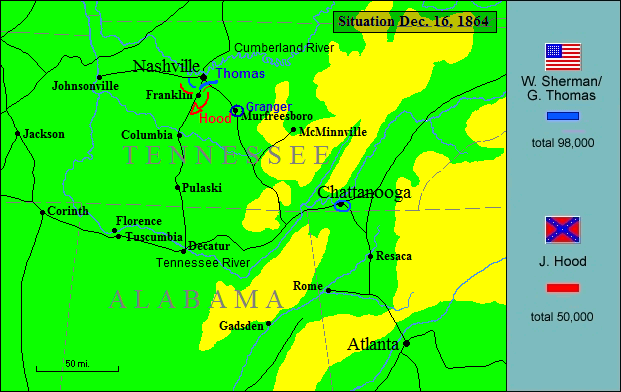Darkest of all Decembers
Ever my life has known,
Sitting here by the embers,
Stunned, helpless, alone.
–Mary Chesnut
Before Sherman set off from Atlanta for the sea, he insisted that he didn’t care where John Bell Hood went with the nearly 40,000 veterans of the Atlanta campaign. If he would go to the Ohio River with them, he joked, he would furnish him rations. To Hood, however, a march to the Ohio River was no joke. It was a cherished dream–if, by November of ’64, also a fevered dream. Having led his army to Tuscumbia, Alabama, following the fall of Atlanta, he now proposed to cross the Tennessee River at Florence and march north to Columbia, Tennessee. He would thus drive his force between Schofield’s 30,000 posted at Pulaski, Tennessee, and Thomas’ 30,000 posted eighty miles to the north at Nashville. Once in control of the Duck River bridges at Columbia, he might strike either Schofield or Thomas–or perhaps even both in detail–and deal the Federals deadly blows. He would then march north through Tennessee and Kentucky, gathering thousands to his colors as he went. Once on the Ohio, he supposed, he might turn east at last and hurry to the relief of Lee in Virginia, for Hood was as ambitious as he was combative. He was also convincing enough to persuade Pierre Beauregard that he could do it. More than that, Grant, ordinarily a hard man to shake, began to believe it might be done and his whole design for dismembering and destroying the South come to naught. His mistrust of Old Slow Trot Thomas had grown, not diminished, since the day his men had stormed Missionary Ridge in that relentless rush.
Hood started his ill-clad, ill-shod, and ill-fed veterans across the Tennessee on November 20. They were bent on the destruction of the two Yankee corps–five divisions in all–under Schofield, Hood’s old mathematics tutor. Screening the way to Columbia ahead were Bedford Forrest and 6,000 hard-riding troopers. Behind them in three columns came the corps of Stewart, Cheatham, and Stephen D. Lee. It was two full days before Schofield realized Hood was around his right flank and headed for his rear, but he acted expeditiously with awareness. On the night of the 22nd, he was headed for the Duck River himself. With the twin advantages of a good road and a shorter route, Schofield was well entrenched on the south bank of the Duck just above Columbia when Hood’s infantry came up on the 26th. The next night Schofield withdrew to the north bank, burned the two bridges behind him, and dug in once more. Though Schofield’s tutoring had helped Hood through West Point, his mentors in the science of war were Lee and Jackson. Just now he would take a page from their book as he had at Atlanta (though that plan had miscarried). Holding Schofield’s front with two divisions of Lee’s corps (the third would go with Stewart) and virtually every gun in his army, he would race to his right with the rest of the army and fetch up in Schofield’s rear at Spring Hill a dozen miles up the Columbia Turnpike. Then it would be flee or fight at bad odds for his old bunkmate.
It was, as Hood remembered it, the “best move in my career as a soldier,” and there is a measure of truth to that judgment. And it is equally true that in the end it came to nothing. Again, Forrest would lead the way on the 29th, this time around Schofield’s left, crossing the Duck ten miles upstream at Huey’s Mill and riding hard for Spring Hill. The infantry would ford the Duck three miles above Columbia and follow. Together they would cut the turnpike to Franklin on the Harpeth River and to the Federal refuge in Nashville beyond. Forrest did his aggressive best, as ever, driving James Wilson’s blue-coated horsemen before him to the north, but the cavalry clash on his left alerted Schofield to Hood’s aggressive intent in that direction. To Schofield now it seemed wise to flee in order to fight. The two divisions of David Stanley he sent north to keep the door to Franklin open for his withdrawal. They did not reach Spring Hill a moment too soon. The lead division–it was George Wagner’s–set up east of the turnpike just in time to throw up breastworks and unlimber their guns. First, somewhere near two o’clock, Forrest’s riders came crashing down only to be beaten back. Two hours later the first of Cheatham’s men–Pat Cleburne’s division–came up and pitched in, but the Yankee artillery fire was too stern even for that stalwart division. At twilight, a second grey division came up and added their weight to a third thrust, only to be likewise driven back. Although a third division was already at hand and four more Confederate divisions were within easy striking distance of an utterly outmanned Federal force at Spring Hill, the brief light of a late autumn day went out after witnessing the failure of three piecemeal Rebel attacks. Incredibly, and to the infinite relief of Schofield, the Rebels went into bivouac. One blue division and its guns had held the road open against Forrest’s horsemen and two grey divisions. Five more grey divisions between Spring Hill and Rutherford Creek, not quite three miles off to the southeast, had gone into camp, not into the fight.
Schofield’s situation as night drew on, however, was embarrassing to say the least. He had three divisions opposite Lee on the Duck, one holding the crossing at Rutherford Creek, and one fighting for its life at Spring Hill. But Hood’s failure to drive home the Spring Hill attack was Schofield’s opportunity. Two of the divisions posted opposite Lee at Columbia headed north in the dark immediately, followed by the third shortly thereafter. When these passed the division at Rutherford Creek, that outfit likewise was to fall into the northbound column. Finally, when they all passed Wagner’s division holding the gate at Spring Hill, Wagner too, now the rear guard, would slip away in the dark. In all, the night of November 29-30 produced an extraordinary spectacle: five Federal divisions tramping north to safety while their enemies slept by their fires barely a musket shot east of the turnpike. So close were the Rebels to the marching bluecoats that some Yankees were captured when they fell out of column to light their pipes on fires they must have supposed belonged to their own flankers. The next morning Hood awoke intending to resume the attack only to discover the Yankee escape. He was, understandably, “wrathy as a rattlesnake,” as one remembered. Less understandably, he, like Bragg before him, blamed the failure on everyone but himself. (In days to come charges and countercharges of incompetence would fill a substantial file.) Hood, however, would go Bragg one better and trace the evil all the way back to beloved Joe Johnston. Johnston in his long retreat from Buzzard Roost Gap to Peachtree Creek, Hood believed, had paralyzed the offensive spirit of this army. They were unwilling to fight except behind works. Hood, however, was resolved to drive them square on the enemy’s works regardless. Long after the war, he wrote that after Spring Hill, “I… decided, before the enemy should be able to reach his stronghold at Nashville, to make that same afternoon another and final effort to overtake and rout him, and drive him into the Harpeth River at Franklin.”
By dawn of November 30, Schofield’s van was on the Harpeth River, and by noon the last of his divisions–Wagner’s–was up. The Harpeth River there flows in a convex loop north and east of the little town. South and west of the town ran the broad convex arc of Schofield’s line anchored on the river above and below the town, well-entrenched and well-supported by more than sixty guns. Behind the river on the Nashville Pike was Thomas Wood’s division in reserve. Also on the north bank covering both flanks were Wilson’s riders. Two of Wagner’s brigades were posted a half-mile out on the Columbia Pike with an eye toward meeting Hood’s advance. If Hood should try to force his way up the pike, they were to withdraw to the main line. It was a sturdy enough position. All Schofield really intended here was to hold it long enough to repair the bridge in his rear and get his wagon train started for Nashville. When darkness came again, he planned to slip away once more and march the final eighteen miles to join Thomas in Nashville.
By two o’clock on a mild Indian summer afternoon, Hood’s van was marching up the pike to Franklin, and Hood himself was determined to contest this ground. In conference with Cheatham, Stewart, and Forrest, he revealed his intention: an all-out, head-on attack against the Federal works. On the face of it, it seemed at best a long odds’ proposition. Schofield was here in numbers greater than Hood’s own and solidly entrenched to boot. An attack on the blue lines would have to cross two full miles of open plain, and as one Yankee observed, there was “not so much as a mullein stalk” to obstruct the Federal field of fire. To make matters worse, S. D. Lee was still on the road with two divisions and a hundred guns. If the Rebels were going to make an attack this afternoon, they would have but eight guns to answer more than sixty of Schofield’s. Cheatham said frankly, “I do not like the looks of this fight.” No man alive relished hard fighting more than Bedford Forrest, but he was convinced that a flank attack, not a frontal assault, was much the wiser course. With his cavalry and a division of infantry, he proposed, he could ford the river and flank the Federals from their works in two hours’ time. But Hood was not to be dissuaded. His original resolve held: “We will make this fight.”
Hood intended to fall on Schofield’s left, between the Lewisburg Pike on the east and Carter’s Creek Pike on the west. The battle lines of six divisions, Cheatham on the left and Stewart on the right, would drive the attack home while a seventh was held in reserve in the center ready to exploit the breakthrough Hood expected. The sun was sinking in the sky by the time all was in readiness. Hood was about to throw some 22,000 fighting men into the assault, nearly 10,000 more than Pickett and Pettigrew commanded at Gettysburg. The broad, bare plain they would have to cross was a full mile wider than Gettysburg’s mile-wide valley of the shadow, and the attack would not fall on a single corps as at Gettysburg, but on virtually the whole of Schofield’s army, 30,000-strong and bristling with cannon. John Bell Hood was putting to a terrible test his conviction that the Army of Tennessee would not fight outside of breastworks. At four o’clock the six divisions of the attack wave, 18,000 men, stepped off smartly in common time, resolved to drive the enemy into the Harpeth River. “For the moment we were spell-bound with admiration,” a Yankee officer remembered, “although they were our hated foes; and we knew that in a few brief moments… all that orderly grandeur would be changed to bleeding, writhing confusion.”
The terrible transformation did not take long. Charging up the Columbia Pike, John C. Brown’s division with Pat Cleburne’s stormtroopers on its right struck Wagner’s two brigades posted a half-mile in front of the main line. Wagner was under orders to withdraw these brigades if and when Hood showed aggressive intent. Two divisions of screaming Rebels running up the pike would seem sign enough for anybody of aggressive intent, but Wagner was not here. He was in his headquarters well within the main line with his third brigade. The two colonels at the point of impact decided to hang on and deliver at least some close-quarter volleys before withdrawing. This they did, slowing for a moment the pace of the Rebel advance. But withdraw they did not, for they were suddenly and thoroughly overwhelmed in a rush of furious Rebels. Nearly a thousand were shot or captured, and the survivors fled in rout toward their works behind. “Let’s run into their works with them!” the Rebels shouted. Now a moiling mass, fleeing Yankees and pursuing Confederates, was running for the Federal trenches where Yankee riflemen and gunners had to hold their fire for fear of shooting their fellows. Over the works the Confederates went “more like a wild, howling mob than an organized army,” a Federal officer recalled. In savage fighting, Hood’s first blow had punched a clean hole in Schofield’s line along the Columbia Pike. Because they had more ground to cover to the point of attack, neither the division on Brown’s left nor the three on Cleburne’s right had yet struck to support the breakthrough. Nor was Edward Johnson’s reserve division close enough to drive through the breached line. Thus, when the Federal reserve under combative and capable Emerson Opdycke came up and delivered a savage counterstroke, Brown and Cleburne’s winded men were first shaken, then slowly and stubbornly driven back toward the Federal trench they had just overrun. Now the fighting seemed a reprise of the struggle for Spotslyvania’s Bloody Angle. Yanks on one side of the works and Rebels on the other, and all firing in each other’s faces as fast as they could rip cartridges and stuff them in muzzles.
While the attack up the Columbia Pike was being blunted, the attack on the Confederate right was being mauled. Stewart’s two right-most divisions had to cross that two-mile plain under artillery fire on their flank. Guns from Fort Granger, an earthwork northeast of the town on the far bank, as well as batteries posted across the river on their right, tore into the Confederate advance. Stewart’s men were fearfully cut up before they even closed with the main Federal line. With virtually no Confederate counter-battery fire, Forrest did what he could to drive the batteries away, sending a division of horsemen across the river. Wilson’s troopers, however, were quick to parry that stroke, and the Federal guns maintained their relentless work. By the time Stewart’s men did strike the Yankee line, already much bloodied, they ran into a volume of rifle fire equally destructive. There they remained, exchanging fire with the entrenched defenders and getting much the worse of the exchange. On the far left of the Confederate assault, Cheatham’s third division under William Bate was having no more success, though at a lesser cost. Only one of its three brigades actually closed with the Federal line (the other two somehow slipping off to the west of the Carter’s Creek Pike). The one brigade engaged, however, was not contributing much but casualties to the Confederate effort. It was sundown by now. Cleburne and Brown were still in a furious fight on the Columbia Pike where they had forced their brief breakthrough. Left and right of them, tough grey-clad veterans were keeping up an increasingly futile struggle.
Most of the exhausted Rebel survivors still on the field could see the futility of keeping up the fight even as they kept it up. Two miles to the rear, however, John Bell Hood, clumping about on his cork leg, could not. At seven o’clock he sent Edward Johnson’s reserve division into the dark confusion behind Cleburne and Brown. They came up manfully enough through the terrible human wreckage of Cheatham’s corps and pitched into the struggle. As one Federal officer recalled, “Time after time they came up to the very works, but they never crossed them except as prisoners.” Had Hood driven Johnson’s division immediately into the breach Cleburne and Brown had made in the first half-hour of the battle, he might have dealt Schofield a destructive blow. As it was, they could now only add to the carnage. And still, the fight went on. One Federal thought that the Rebels fought “with the very madness of despair.” Somewhere near nine o’clock even Hood was willing to call it quits. It wasn’t until eleven that the fighting finally sputtered out for good. By that time S. D. Lee was up with his two divisions and the army’s guns. Hood was already drafting orders to renew the attack in the morning following a bombardment of Schofield’s works. Those orders were altogether moot, however, because sometime near midnight Schofield was beginning to cross the Harpeth on his way to Nashville, which was, after all, all he intended in the first place. The next morning Hood took possession of some Tennessee real estate that his adversary had been perfectly willing to concede for free. Yet Hood’s cost was more than 6,000 dead, wounded, and captured men against slightly more than 2,000 in Schofield’s command (very nearly half of these came from Wagner’s unfortunates). Hood had lost almost as many as Grant at Cold Harbor, even though Grant had wagered two-thirds as many men. The slaughter in Hood’s officer corps was disproportionately disabling. Just over a hundred regiments were engaged on November 30. Fifty-four of their commanders were lost. Twelve brigade or division commanders likewise. Twelve Confederate generals were casualties of war, five of these dead and one dying. After the battle, the five were laid out on the porch of the handsome Charnton House in Franklin. These included irreplaceable Pat Cleburne and States Rights Gist, who had been in Charleston the morning the trouble started. John Hood had not driven Schofield into the Harpeth River; still, for what it was worth, he had proved that the Army of Tennessee would fight outside breastworks. Neither the men nor their commander knew it at the time, but they had just one more fight left in them.
In fact, the Battle of Franklin, which had cost so much and gained so little, had very properly shaken the Army of Tennessee. Since Hood had crossed the Tennessee on November 20, the army had suffered 7,500 casualties, nearly a quarter of those who had set out from Florence just ten days before. “We were ready to flee, fight or fortify,” a private soldier remembered. “I have never seen an army so confused or demoralized. The whole thing seemed to be tottering and trembling.” (This was a man who had survived the fierce and futile struggles under Braxton Bragg.) What Hood would do next with this diminished band was unclear. Having failed to trap Schofield at Spring Hill or to injure him at Franklin, Hood could do no more immediately than to send Forrest up the pike to harass his rearguard. Once Schofield was in Nashville to enlarge the command Thomas was cobbling together there, Hood’s choices were narrow in the extreme. One thing he surely could not do was drive Thomas out by force. Including the 9,000-man garrison at Murfreesboro to the southeast plus smaller garrisons elsewhere in Tennessee, Thomas commanded more than 70,000 men. Nashville was, moreover, as heavily fortified a place as existed west of the Appalachians. Hood might stay where he was on the defensive or even fall back to another rearward line and await events, but that would mean accomplishing nothing in particular while Grant battered Lee on the Richmond-Petersburg line and Sherman continued his systematic dismantling of Georgia. (Uncle Billy was already nearly to Savannah.) To march around Thomas’ flank toward his rear and the Ohio River was thinkable but unlikely since it would expose his own rear to a ponderously larger enemy, an enemy who could, in addition, be reinforced if an urgent occasion demanded more manpower. In the end Hood did the one thing he thought possible: follow Schofield to Nashville, dig as sturdy a line as he could, and wait for Thomas to attack. A fierce enough repulse, he had to believe, would create an opportunity for an equally fierce counterstroke that would give him Nashville and open a way to the Ohio. It was not much to believe in, but as the bloodiest year in the nation’s history drew toward a close, it was perhaps all that was left to believe in. The alternative, as Hood understood it, was to live under the oppression of Yankee rulers and their “Negro allies.”
On December 2 Hood reached the outskirts of Nashville and took a good, long look at the ten-mile arc of Federal line before the capital. On high ground, generously supported by guns and forts, supported further by a line of inner works, the line was securely anchored on the Cumberland River above and below the city. The men who held these lines were in the main fit, fed, and rested. Four miles south of the city Hood proposed to dig in and invite attack. The line Hood intended was to run from river to river likewise, but there was the terrible rub: to hold it he had but 22,000 riflemen. Running river to river, it would be little more than a skirmish line. Again, Hood made the best of a bad lot. He laid out a four-mile line stretching from the Hillsboro Pike on his left and extending just beyond the Nolensville Pike on his right, Stewart on the left, Lee in the center, and Cheatham on the right. That meant of course that Thomas’ superior force overlapped Hood both right and left–and most critically on the left. Cheatham’s right-most man was still two miles from the Cumberland and Stewart’s left-most four miles off. Further, if Thomas intended to strike either flank, he had two good and virtually undefended roads on his own left and two on his right. It was not the best ground on which to invite an attack, but it was perhaps as good as any Hood might have chosen given the long odds against him.
Hood did see quite clearly how vulnerable his left was and ordered a series of three redoubts constructed on Stewart’s left and rear west of the Hillsboro Pike. While these were under construction, Hood’s dark luck manifested itself again in the form of an Act of God on December 8. He had made his Franklin attack in tranquil Indian summer. Now, as it sometimes will in that part of Tennessee, the weather took a nasty turn. Rain turned to sleet, sleet turned to snow, and the Tennessee clay froze to ice-glazed concrete that no man could break, most particularly barefoot and weary Rebels. Four days the hard cold continued, and then the weather played one more grim joke on the men of the Army of Tennessee. A thaw came on and turned the immovable concrete into immovable mud on the 13th. Thus, the critical redoubts remained very sketchy works. But if the weather paralyzed Hood’s army, it stuck Thomas in place as well for five full days, just when he was trying to get preparations for an attack in motion. In fact, Thomas was under relentless pressure to do precisely that. On December 2 Grant wired Thomas: “move out of Nashville with all your army and force the enemy to retire or fight on ground of your choosing.” Grant, normally a man of few words, was going to expend a full measure of them on Virginia-born George Thomas in the next two weeks. Stinging wires brought always the same order: attack, and now. Others, more so, attack, and now, or you will be relieved of your command.
If Grant was exasperated, Thomas was likewise. Turning a jumble of commands into an effective offensive force would take time. Gathering the horse flesh he would need to remount his cavalry to deal with Forrest would take time. These considerations he tried to make Grant appreciate, but they brought the same riposte: attack. Then, on the 8th, the ice storm brought all movement to a halt. To this, too, Grant was insensible, and Thomas had every reason to wonder how a man 500-odd miles from his front could know what was possible on it. In fact, Grant was not altogether himself at this point. His position as general-in-chief of all the armies had certainly laid a heavy burden on him and compelled him to rely on subordinates he did not entirely trust. Even as he was trying to prod Thomas into action at Nashville, he was also trying, in the same seething exasperation, to get Ben Butler’s combined army and navy forces in motion toward Wilmington. The one subordinate he trusted implicitly, Tecumseh Sherman, had gone down a hole at Atlanta and had yet to emerge from it at Savannah. In his anxiety Grant actually believed Hood could slip Thomas’ grasp and march to the Ohio. On the 13th his patience snapped, and he sent Black Jack Logan west to relieve Thomas of command unless he had already delivered or was just about to deliver a blow. Long after, Grant ventured, ungenerously to both Hood and Thomas, that if he had been in Hood’s place, he would have marched all the way to Chicago. At the time, however, Grant was ignorant of two crucial facts. One was that Hood’s army was already badly hurt, diminished by its combat losses, and losing strength daily by desertion. The second was that George Thomas was securely in control.
Even as Black Jack Logan was on his way west with Grant’s order, the roads in Tennessee dried and Thomas set about his final preparations for attack. He had an assault force 54,000 strong and was going to use all of it. (The 8,000-man Nashville garrison would occupy the front lines as soon as the attackers stepped off.) Thomas had seen Hood’s vulnerable left as clearly as Hood, and the essence of his design was to hold with his own left and swing hard from the right, flanking and overwhelming the western end of the Confederate line. On his own left, James Steedman would feint against Cheatham and hold him there. On the far right, Wilson’s horseman would swing in a wide arc around the Rebel flank and sweep down in the neighborhood of Hood’s left-most redoubt. (Wilson wouldn’t have to worry about Forrest here; Hood had sent him off to Murfreesboro to wreck track and discomfit the garrison there.) The business end of the attack would be driven home by A. J. Smith, right-center, and Thomas Wood, center. These too would wheel left and fall on Stewart’s line where it bent sharply south to parallel the Hillsboro Pike. (Wood had an old score to settle: it had been his outfit pulled out of line at Chickamauga that let Longstreet through.) Finally, Schofield’s command, left-center, would follow the same arc and look for a likely place to pitch in. If all went well, virtually the whole weight of Thomas’ assault would fall on the left of Hood’s four-mile line. Beefy, deliberate, imperturbable George Thomas was just about to throw a rocking right-hand punch.
First, Thomas issued three days’ rations and sixty rounds. Then, despite what Grant had to say on the subject (which was to ignore it), he waited for the weather. On December 13 came a thawing rain and the next day sunshine. Thomas resolved to attack at first light on December 15. On that foggy morning, first light did not fully break until 8:00, at which time Steedman’s three heavy brigades (two of these black troops) stepped off in the slop toward Cheatham’s lines on the Confederate right. Cheatham’s men were dug in on high ground on and around Rains Hill and a railway cut east of the Nolensville Pike, veterans fully prepared to receive an attack. Steedman’s brigades kept up their attacks stoutly enough for two hours, accomplishing nothing at all in the way of driving the Confederate right, and stalled. But that, after all, was all they needed to accomplish: hold the Rebel right while the main blow fell on the left. Wilson’s cavalry (a third of them still dismounted for lack of horses) were supposed to lead the way to the left, and not long after Steedman’s attack against Cheatham stepped off, Thomas ordered Wilson to head out against Stewart. No sooner did Wilson’s troopers start than they, too, stalled–not, however, from Rebel rifle fire but by their own traffic. A. J. Smith, attempting to dress his lines on Wood to his left, blocked the two west-most turnpikes Wilson was supposed to be riding down. It was 10:00 before the Charlotte and Harding pikes were cleared, but Wilson then went forward briskly enough, driving the sketchiest resistance before him. Behind him came Smith’s men. By mid-day, the whole force–horsemen, dismounted troopers, and infantrymen, 24,000 fighting men in all–were forming up opposite the mile-long stretch of Rebel line along the Hillsboro Pike. Confederates in the three unfinished redoubts and behind a low stone wall prepared for the shock. Shortly after noon, Federal guns began to hammer away at the Rebel works in preparation for the imminent assault.
About the same time, Thomas ordered forward some more infantry muscle. Wood, in the center of the Federal line, now began his left wheel. Thus, just as Smith was massing for his attack from the west, Wood was pressing down from the north to strike what was in effect the hinge of Stewart’s line, that sector where his east-west line bent sharply south. By 1:30 Smith’s bombardment ceased and his men went forward with Wilson’s troopers to close with the grey infantry and their guns. Soon after, Thomas sent the last of his strike force, Schofield’s corps, wheeling left also. Very nearly 50,000 Yankees were now bent on the destruction of one Rebel corps. The battle was approaching its critical hour, and Hood knew it. Stephen D. Lee’s corps in the center had hardly been engaged at all thus far, and now Hood ordered Johnson’s division to hurry to the embattled left. On the right, Cheatham’s corps was holding its front capably, and Hood sent Bate’s division to the west likewise. Whether these two divisions would arrive before Stewart caved in would depend in large part on what the Rebels in those unfinished redoubts could manage. Each redoubt mounted four guns and was supported by a handful of infantry. Now the gunners were ripping double canister into the attacking blue waves as fast as they could ram shells home. Their fire was hot enough to stall Smith’s men in front of the north and center works, but the south-most redoubt–the extreme left of Hood’s whole army–was exposed on its flank. On that exposed redoubt Wilson’s dismounted troopers fell with a furious rattle of their seven-shot Spencers, overwhelmed it left and right, and finally seized it from the rear.
The fall of that fort exposed the redoubt next in line to the north, and now its guns were blazing away front and flank, Smith pressing from the west, Wilson from the south, and Wood of course still hammering furiously on the angle to the north. Though by now two of Johnson’s brigades had arrived, the Federal pressure was relentless. As the winter afternoon wore on, the center redoubt fell and soon after the last of the three on this stretch of line. (Two to the north still kept up the fight.) Worse yet for Stewart, Schofield was now up and forming on Smith’s right. When all his men were in line, they would be well beyond the Confederate flank in position both to crumple his flank and cut off his retreat. By 4:30, very nearly sundown, Stewart ordered a withdrawal before his corps collapsed at both ends. In the last light of day, he fell back a mile, surrendering the Hillsboro Pike but covering the Granny White Pike just east of it. With the arrival of Bate’s division as well Johnson’s other two brigades, Stewart extended his threatened left and anchored his right once more on S. D. Lee. It was a smart piece of soldiering. After a wearing day-long fight against vastly superior numbers, he had got his corps out in good order in the dark–despite losing sixteen guns and more than a thousand prisoners in addition to his dead and wounded. In all, Hood’s army counted 2,200 casualties from the time the fog lifted that morning until its withdrawal at twilight. Darkness and the Federals’ own victorious disorder had prevented Thomas from completely enveloping and destroying the Confederate left.
Thomas sent his men into bivouac wherever they happened to halt at twilight and wired to Washington of the day’s success. When the message reached Grant, he was much relieved to learn that Thomas had moved at last. Grant wired back sometime near midnight urging Thomas to push on in the morning with everything and delay for nothing, adding “Much is now expected.” (A little later Grant wired again, remembering that he ought to send congratulations as well as instructions.) Pushing on in the morning was precisely what Thomas intended–if, of course, Hood was still there to strike and not already on his way back to the Harpeth River. At the gates of Atlanta when Hood had succeeded Joe Johnston, Schofield had given Sherman some good counsel about his new adversary: “He’ll hit you like hell, now, before you know it.” Hood was as good as his old bunkmate’s word, fighting three furious battles in eight days. Now Schofield went to Thomas with good counsel: “You don’t know Hood. He’ll be right there, ready to fight you in the morning.” Indeed, he was, just two miles south of where his lines had been the morning before. While Thomas’ men slept, Hood’s weary soldiers had been at work with pick and shovel. Lee held the right now, his right posted on Overton Hill and covering the Franklin Pike. Stewart’s corps, which had borne the brunt of yesterday’s fighting, held the center. Cheatham anchored his left on a hill just west of the Granny White Pike, known today as Shy’s Hill for a youthful Tennessee colonel, William Shy, who would die there in its defense before the day was done. Such of Forrest’s cavalry that remained with Hood were posted in Cheatham’s rear to prevent Wilson’s horsemen from slicing across the Granny White Pike. The line ran just two miles from hill to hill, half the length of yesterday’s and gaining something in strength by compression. Still, in the face of Thomas’ numbers, it was vulnerable on both flanks. It was the left again, however, that Thomas hoped to crush.
The tactics he intended were virtually those of the day before: hold the Confederate right while the lethal blow fell on the left. There was, however, this change. The holding attack on the right was to be no feint but a head-on assault to drive the Rebels off Overton Hill. For all of Grant’s urging on to hot haste and Thomas’ best efforts, getting in position to give battle would require a good deal of sorting out of the disordered elements of yesterday’s victorious army. Not until noon were Steedman and Wood in place opposite Overton Hill. On Wood’s right was Smith, and where Cheatham’s line bent southward west of the pike Schofield stood preparing to attack once more from the west. South of Schofield was the extreme right of Thomas’ line, Wilson’s cavalry easily overlapping the last infantryman on the Confederate left. About noon on December 16 fighting broke out again with Steedman and Wood’s attack on Lee on the Confederate right. For the Federal effort, this stretch of Confederate line was the worst possible place to strike. Lee’s men had had the least of yesterday’s struggle, and two-thirds of these had missed the slaughter at Franklin. They were at virtually full strength and their unshakable defense of the soggy slopes showed it. For three hours the Federals struck and struck again only to be driven back by determined musketry and effective artillery fire. The Federals were holding the Confederate right, it was true, but paying a fearful price. By three o’clock they were about fought-out and broke off the attack. (Although the civil rights amendments to the Constitution were still in the future, the nation was moving grimly toward integration this winter day. Two of Steedman’s brigades were black. “After the repulse,” Wood noted, “our soldiers, white and colored, lay indiscriminately near the enemy works.”)
On the Confederate center and left no Yankee infantry had yet been committed to the fight, though their artillery and cavalry had been busy enough. Shy’s Hill was the central object of the Union gunnery, and with nearly a hundred guns brought to bear, the Confederates there were taking a pounding. To add to the defenders’ misery, sometime after mid-day a chilling rain began to fall as steadily as the shells. South of the disputed hill, James Wilson’s troopers were having much the better of the fight against out-manned and out-gunned Rebel cavalry under James Chalmers. With two divisions on foot and two more on horseback, Wilson had cut the Granny White Pike south of Cheatham about the same time Steedman and Wood’s noontime attack had stepped off. Again, a crisis on the Confederate left was in the making. With the road in Cheatham’s rear closed, only one route to safety remained should the Army of Tennessee be compelled to surrender the field–the Franklin Pike in Lee’s rear. The whole force of Smith, Schofield, and Wilson was poised to strike the Rebel left from north, west, and south, and there was no reason to believe that Thomas would not do so soon. Hood himself had already contributed to the growing danger there. Worried about the security of Lee on his right, he had sent three brigades from Cheatham on Shy’s Hill to Overton Hill. They reached that place a half-hour too late to have any part of its defense, and probably they weren’t needed there in any event. What was certain was they would not be on hand for the defense of the left when the blow that was surely coming at last fell.
Several Union men had been, in their respective ways, urging Thomas to strike that blow immediately. On the field, Wilson had since mid-day sent rider after rider to Schofield telling him that he had gained the Rebel rear and that it was high time for him and Smith to push off. Opposite Shy’s Hill on Smith’s front two division commanders, John McArthur and Darius Couch, were inching closer to the slopes and urging attack, indeed volunteering to attack, as well. Even in far-off Washington Lincoln had wired Thomas at mid-day the nation’s gratitude for yesterday’s triumph. The generosity and tact were altogether characteristic. But with the generosity went this aggressive directive: “You made a magnificent beginning. A grand consummation is within your easy reach. Do not let it slip.” The aggressive intent was not less characteristic. In his lonely White House command post, Lincoln had seen too many opportunities slip away, had read too many telegrams puffing about total victories that had come to nothing except more bloodletting. It was nearly four o’clock now, three-quarters of an hour to sunset, not quite two hours to full dark. Schofield was the man dragging his feet, insisting that he needed a division from Smith before he could go forward. Then at last Old Slow Trot himself ambled up to confer with Schofield and an outraged James Wilson (who had ridden up to urge Schofield on in person). George Thomas, who had endured more than enough instruction from the chain of high command from Lincoln to Stanton to Grant to Halleck in the past two weeks, now gave a quiet and courteous command to John Schofield: “Please advance your entire line.”
For Hood’s part, he was willing to believe that the hour of crisis had passed with the Yankee failure on his right and the grey light of a wet winter afternoon fading fast. He was already planning a withdrawal in the darkness in preparation for an attack the next morning on the Yankee right, intending to catch them on the flank as he had been caught the day before. But the crisis had not passed. It exploded on his own left the moment that Thomas sent Schofield forward. As Schofield struck from the west, Smith’s men barreled up the muddy slopes of Shy’s Hill from the north and Wilson’s dismounted troopers poured in from the south with their rattling repeaters. Bate’s division on Cheatham’s left, badly handled and badly used throughout the campaign, gave way first under fire from front and rear. So sudden was Bate’s collapse that all three of his brigadiers were swept up as prisoners of war. (William Shy and his Tennesseeans did not break here, however, and he was killed facing the flood of Yankee attackers overwhelming the position.) But the flood, having been loosed, was now relentless, and the Army of Tennessee was quickly collapsing left to right. Cheatham’s corps, piece by piece and then all at once, folded up and ran in headlong flight for the Franklin Pike, the sole remaining avenue of escape. With the left so suddenly and violently unhinged, Stewart’s corps in the center gave way in turn, and another prisoner of high rank, Edward Johnson, was hustled away to the Yankee lines with hundreds of others of lesser rank for company. (Unlucky Edward Johnson had been captured once already in this conflict; taken at Spotsylvania, he had been a free man only since his exchange in October.) Within a half-hour of Thomas’ order, some two-thirds of Hood’s army was reeling southward in disorder. In their flight, one of Thomas’ staff officers saw “an army… changed into a mob, and the whole structure of the rebellion in the Southwest, with all its possibilities… overthrown.” Hood himself later admitted that he “beheld for the first and only time a Confederate army abandon the field in confusion.” Hood of course had been recovering from his Gettysburg wound when the Cumberland men had driven Braxton Bragg in confusion from Missionary Ridge just over a year before.
The Confederate cause in the West had just two things going for it in the sodden darkness of December 16. One was the parallel confusion in the Yankee ranks bred of their own galloping onslaught. The other was the presence of mind of Stephen D. Lee. He had seen his comrades collapsing west to east from his post on Overton Hill and rushed west to rally the grey fugitives. With a handful of infantry and a few guns, Lee just managed to check the Yankee advance long enough to get his right-most division in line a half-mile down the pike. A little later a second division joined it, and together they held the door of the Franklin Pike open for the fragments of the Army of Tennessee to stream southward toward the Harpeth. Hood himself tried to rally his men near Brentwood, but as one Rebel recalled, it was like trying to hold back the Duck River current with a fishnet. A stiff rear-guard and the exhaustion of the pursuing Yankees saved the Confederates further destruction that night. But the blow that had been struck the Army of Tennessee at Nashville would turn out to be mortal. In two days Hood had lost fully 6,000 men against half that in Thomas’ army. Revealingly, 4,500 of Hood’s casualties were prisoners of war, a sure sign of an army beaten in spirit as well as on the field. For an artilleryman, losing a gun is a disgrace comparable to an infantryman losing his colors, yet 53 Rebel guns were yielded in those two days. John Bell Hood was acutely aware of how badly his army had been whipped. A Rebel private found him that night in his tent “much agitated and affected… and crying like his heart would break.” That same soldier, long after the war, took a fair measure of John Hood: “I always loved and honored him, and will ever revere and cherish his memory… As a soldier, he was brave, good, noble, and gallant, and fought with the ferociousness of the wounded tiger, and with the everlasting grit of the bulldog; but as a general he was a failure in every particular.” Peachtree Creek, Atlanta, Ezra Church, Jonesboro, Spring Hill, Franklin, and now Nashville. The wet, one-armed, one-legged commander of a broken army had full cause for tears.
Across the way no one could blame the Yankees for lifting cheer after cheer–”the voice of the American people,” Thomas thought. Nor could any properly begrudge George Thomas a rare moment of jubilant crowing. “Didn’t I tell you we could lick them?” the normally soft-spoken and stolid Virginian boomed. “Didn’t I tell you we could lick them?” Nashville was a decisive and profoundly destructive victory wrought by a general who Grant had made up his mind to fire three days earlier. Thomas continued his pursuit of the crippled army throughout the remainder of December, but the return of Forrest’s cavalry made a running rear-guard fight of it at every crossing. Of the retreating Rebels, Schofield wondered “if any soldiers in the world ever needed so much cumulative evidence that they were beaten.” But they were, and they knew it. Barefoot, hungry, sick at heart, stragglers fell out and deserters went home. At year’s end, Hood’s survivors were back across the Tennessee once more, in winter camp at Tupelo, Mississippi. They numbered just half of the 40,000 who had crossed the Tennessee in November, headed, Hood then believed, for the Ohio. One road-weary Rebel considered their collective condition: “Ain’t we in a hell of a fix: a one-eyed president, a one-legged general, and a one-horse Confederacy.” The president would remain defiant to the last. The general would resign on January 13. The Confederacy would live out the winter and a little more. Three days after Hood’s rout, Mary Chesnut confided to her diary: “The deep waters are closing over us.”

